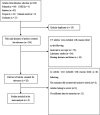Association between cadmium exposure and urolithiasis risk: A systematic review and meta-analysis
- PMID: 29505519
- PMCID: PMC5943130
- DOI: 10.1097/MD.0000000000009460
Association between cadmium exposure and urolithiasis risk: A systematic review and meta-analysis
Abstract
Background: We performed a meta-analysis to determine whether a consistent relationship exists between cadmium exposure and urolithiasis in humans. Accordingly, we summarized and reviewed previously published quantitative studies.
Methods: Eligible studies with reference lists published before June 1, 2017 were obtained from searching several databases. Random effects models were used to summary the overall estimate of the multivariate adjusted odds ratios (ORs) with 95% confidence intervals (CIs).
Results: Six observational studies involving 88,045 participants were identified and stratified into the following categories according to cadmium assessment results: occupational (n = 4) and dietary (n = 2). The findings of the meta-analysis suggested that the risk of urolithiasis increases significantly by 1.32 times at higher cadmium exposure (OR = 1.32; 95% CI = 1.08-1.62; for highest vs lowest category urinary cadmium values). The summary OR in occupational exposure (OR = 1.56; 95% CI = 1.13-2.14) increased at the same condition. Meanwhile, no association was observed between cadmium exposure and urolithiasis risk in dietary exposure (OR = 1.13; 95% CI = 0.87-1.47). A significant association remained consistent, as indicated by subgroup analyses and sensitivity analyses.
Conclusions: The meta-analysis indicated that increased risk of urolithiasis is associated with high cadmium exposure, and this association is higher in occupational exposure than in dietary exposure. Nevertheless, well-designed observational studies with different ethnic populations are still needed.
Copyright © 2017 The Authors. Published by Wolters Kluwer Health, Inc. All rights reserved.
Conflict of interest statement
The authors declare no conflicts of interest.
Figures




Similar articles
-
Selenium for preventing cancer.Cochrane Database Syst Rev. 2018 Jan 29;1(1):CD005195. doi: 10.1002/14651858.CD005195.pub4. Cochrane Database Syst Rev. 2018. PMID: 29376219 Free PMC article.
-
Antiretroviral post-exposure prophylaxis (PEP) for occupational HIV exposure.Cochrane Database Syst Rev. 2007 Jan 24;2007(1):CD002835. doi: 10.1002/14651858.CD002835.pub3. Cochrane Database Syst Rev. 2007. PMID: 17253483 Free PMC article.
-
Heated tobacco products for smoking cessation and reducing smoking prevalence.Cochrane Database Syst Rev. 2022 Jan 6;1(1):CD013790. doi: 10.1002/14651858.CD013790.pub2. Cochrane Database Syst Rev. 2022. PMID: 34988969 Free PMC article.
-
Closed-system drug-transfer devices plus safe handling of hazardous drugs versus safe handling alone for reducing exposure to infusional hazardous drugs in healthcare staff.Cochrane Database Syst Rev. 2018 Mar 27;3(3):CD012860. doi: 10.1002/14651858.CD012860.pub2. Cochrane Database Syst Rev. 2018. PMID: 29582940 Free PMC article.
-
Electronic cigarettes for smoking cessation.Cochrane Database Syst Rev. 2022 Nov 17;11(11):CD010216. doi: 10.1002/14651858.CD010216.pub7. Cochrane Database Syst Rev. 2022. Update in: Cochrane Database Syst Rev. 2024 Jan 8;1:CD010216. doi: 10.1002/14651858.CD010216.pub8. PMID: 36384212 Free PMC article. Updated.
Cited by
-
Environmental cadmium exposure and the risk of kidney stones: a systematic review and dose-response meta-analysis.Front Med (Lausanne). 2025 Jul 30;12:1555028. doi: 10.3389/fmed.2025.1555028. eCollection 2025. Front Med (Lausanne). 2025. PMID: 40809422 Free PMC article.
-
Estimation of health risks associated with dietary cadmium exposure.Arch Toxicol. 2023 Feb;97(2):329-358. doi: 10.1007/s00204-022-03432-w. Epub 2023 Jan 2. Arch Toxicol. 2023. PMID: 36592197 Review.
-
Lifestyle Factors and the Microbiome in Urolithiasis: A Narrative Review.Nutrients. 2025 Jan 27;17(3):465. doi: 10.3390/nu17030465. Nutrients. 2025. PMID: 39940323 Free PMC article. Review.
-
Association and interactions between mixed exposure to trace elements and the prevalence of kidney stones: a study of NHANES 2017-2018.Front Public Health. 2023 Oct 26;11:1251637. doi: 10.3389/fpubh.2023.1251637. eCollection 2023. Front Public Health. 2023. PMID: 37965524 Free PMC article.
-
DNA Sensors for the Detection of Mercury Ions.Biosensors (Basel). 2025 Apr 29;15(5):275. doi: 10.3390/bios15050275. Biosensors (Basel). 2025. PMID: 40422014 Free PMC article. Review.
References
-
- Pearle MS, Calhoun EA, Curhan GC. Urologic diseases in America project: urolithiasis. J Urol 2005;173:848–57. - PubMed
Publication types
MeSH terms
Substances
LinkOut - more resources
Full Text Sources
Other Literature Sources
Medical

